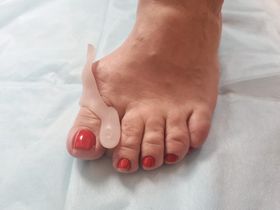Can Flat Feet Be Corrected and Cured in Adults?
Learn about the treatment of flat feet, the types, and the best ways to manage them.
Updated February 17, 2023.
Flat feet are characterized by fallen arches, leading to most of the inner foot making contact with the ground when bearing weight. Flat feet lead to an inward-turning (overpronation) of the ankles and lower leg, which may lead to pain in the foot itself, as well as the ankle and knee.
Can Flat Feet Be Corrected Naturally?
Conservative remedies won't cure flat feet but may help reduce symptoms.
Different Types of Flat Feet
There are two types of flat feet.
The first is Flexible Flat Feet (FFF), often seen in childhood due to weakened muscles and lax ligaments of the foot. When lying down, the foot has an arch, but it disappears under weight.
The second is Rigid Flat Feet (RFF) which are characterized by feet that don’t change shape when weight is applied or removed. The foot is stiff and has little range of motion.
Best Ways to Treat Flat Feet
Flat feet can be managed well with support from orthotics and through other remedies such as exercise. The arch support from orthotics will give the foot a base to prevent overpronation from occurring. Orthotics for flat feet aid in distributing the weight correctly through the foot. The muscles of the arch can be strengthened using exercise, which will further improve and support the arch. Calf muscle stretching has also been proven to reduce pain levels.
How to Fix Flat Feet
Surgical intervention in flat feet is considered when conservative management hasn’t improved the patient’s symptoms. A tendon transfer, fusion, or osteotomy can be considered by your Podiatrist to aid you in your condition, based on assessment and imaging studies.
Surgery for flat feet has shown an extremely high rate of success of around 95%. Infection, nerve or blood vessel damage, and a failure of the bones or wounds to heal completely are all risks involved with surgical intervention.
Related Articles

Babafemi Adebajo
Can Knee Pain Be Caused by Overpronation of the Foot?

Babafemi Adebajo
Do Bunion Correctors Really Work?
Related Posts
Babafemi Adebajo
Secondary Conditions Associated With Flat Feet
Babafemi Adebajo
Upstep Custom Orthotics for Flat Feet—2024 Review
Janik Sundstrom
Best Exercises for Treating Flat Feet
Babafemi Adebajo
Secondary Conditions Resulting From Flat Feet
Babafemi Adebajo
Best Orthotics for Flat Feet and Plantar Fasciitis
Babafemi Adebajo
How to Know if You Need Arch Support
Janik Sundstrom
Conservative and Invasive Treatments for Flat Feet
Janik Sundstrom







